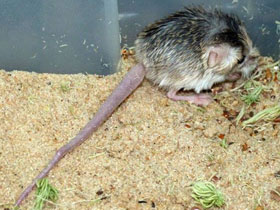The thick-tailed pygmy jerboa (Salpingotus crassicauda)
The thick-tailed pygmy jerboa (Salpingotus crassicauda) is a species of rodent in the family Dipodidae.
Habitat
Salpingotus crassicauda is distributed in sandy deserts and semi-deserts of the northern half of Central Asia and the extreme east of Kazakhstan. In Kazakhstan it is found only in the Zaisan Basin (north-western edge of the species range). In Central Asia its range covers western and southern Mongolia and north-western and northern China.
Distinguishing features and appearance
Salpingotus crassicauda reaches a body length of 53-55 mm, tail length is about 100 mm, and it weighs 9-10 g. Sexual dimorphism in this species is expressed only in the size of the terminal tassel of the tail: in males it is 2 times larger than in females. The feet of Salpingotus crassicauda are very long, about 22 mm. The top of the head and back are covered with light ochre-grey fur, darkened by longitudinal jetting. Head hair and fur are tri-coloured: base is greyish-white (about 75 % of length), gradually changing to ashy or dark grey, followed by a pale or bright ochre belt (15-20 % of length), apex is dark grey. The rings around the nose, lips, throat, breast, abdomen, outer and inner surfaces of the fore and hind limbs and the brush on the stupa are pure white. White rings are present around the eyes and ears. The tail is covered with short, dense hair. The tail is white underneath and a pale greyish ochre above. A light grey tassel is present at the end of the tail.
Lifestyle and habits
Salpingotus crassicauda is active only in the shade. Its burrow is a single passage with chambers and dead ends. When collecting food, the animals move with short jumps of about 2 cm in length. When running fast, the length of their jumps reaches 18-25 cm.
Salpingotus crassicauda, inhabiting the Zaisan Basin, hibernate in the first-third decade of September. They awaken at the end of April. Before hibernation the increase in weight of animals up to 12-13 g is recorded.
What it feeds on
Salpingotus crassicauda diet is based on seeds, spiders and insects (grasshoppers, butterflies, small beetles). Invertebrates dominate the diet in spring and early summer, and seeds in the second half of summer. Daily feed intake in captivity is 3-4 g, i.e. 30-50% of body weight.
Breeding
In the Zaisan Valley, breeding of Salpingotus crassicauda begins at the end of the first decade of May. However, these dates can vary from the end of April to the third decade of May, depending on the weather. After the first cubs are born, the second breeding cycle begins. The duration of gestation is not precisely determined, presumably it lasts from 19 to 25 days. There are from 1 to 6 cubs in a brood. The period from birth to emergence from the dens lasts 24-25 days. Sexual maturity occurs in 9-11 months of life after the first hibernation. The maximum lifespan of these animals in the wild is no more than three years.
Status
The thick-tailed pygmy jerboa varies in its spatial distribution and its populations are subject to large fluctuations. Threats it faces include predators, droughts, overgrazing of its habitat, destruction of its burrows and road kill. Insufficient evidence is available for the International Union for Conservation of Nature to assess its conservation status so it is listed as "data deficient".
















































